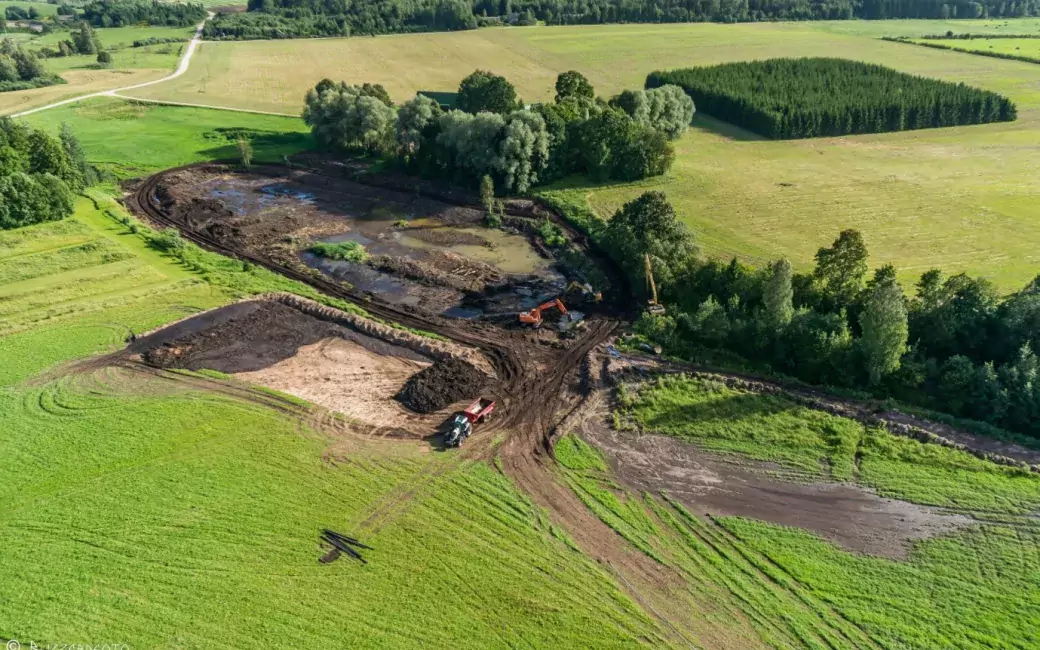Recycling Lake Sediments For Crop Production: A Sustainable Solution For Closing The Phosphorus Cycle
A four-year field experiment conducted on the shores of restored Lake Mustijärv in Viljandi, Estonia, has revealed that recycling phosphorus-rich lake sediments back to agriculture could have positive impacts on crop production
A four-year field experiment conducted on the shores of restored Lake Mustijärv in Viljandi, Estonia, has revealed that recycling phosphorus-rich lake sediments back to agriculture could have positive impacts on crop production
 Aerial view of the excavation process at eutrophic Lake Mustijärv, located in Viljandi, Estonia, taken in August 2016. (Image: Kristjan Lust) The study was conducted by doctoral researcher Mina Kiani and the AgriChar research group, and it is globally the first of its kind to cover the environmental aspects of recycling lake sediments to agriculture over several years. Kiani defends her thesis on 21 April at the University of Helsinki Faculty of Agriculture and Forestry.
Aerial view of the excavation process at eutrophic Lake Mustijärv, located in Viljandi, Estonia, taken in August 2016. (Image: Kristjan Lust) The study was conducted by doctoral researcher Mina Kiani and the AgriChar research group, and it is globally the first of its kind to cover the environmental aspects of recycling lake sediments to agriculture over several years. Kiani defends her thesis on 21 April at the University of Helsinki Faculty of Agriculture and Forestry.
The study aimed to find a sustainable solution for closing the leaking agricultural phosphorus (P) cycle by recycling P-rich lake sediments back to agriculture and helping the restoration of the eutrophic lake by sediment removal. The experiment involved excavating all 7500 m3 of sediment from the 1-hectare shallow eutrophic Lake Mustijärv, which was then used as a growing medium for grass production. The sediment was also analysed for various essential nutrients, including P, sulphur (S), calcium (Ca), magnesium (Mg), boron (B), zinc (Zn), and copper (Cu).
The results showed that sediment-based growing media sustained the grass biomass yield in the field condition, with the sediment being rich in organic matter and a good source of several essential nutrients. Additionally, the sediment continuously provided a moderate supply of N to the plants over the four-year field experiment.
The study also investigated the environmental impacts of various sediment application methods, including greenhouse gas emissions, N and P leaching, aggregate stability, and soil biota. Sediment-based growing media had different bacterial and fungal community compositions compared with soil, and it increased the risk of P and mineral N leaching. Biochar application increased the amount of N taken up by the plants but did not significantly reduce emissions or leaching.
The sediment application rate should be adjusted to match crop requirements, similar to how fertilizers are applied. This can help minimize nutrient leaching back into the lake and further help mitigate eutrophication of the lake.
Furthermore, in this project, the changes in P dynamics at the sediment–water interface in the restored lake were examined during a two-year follow-up period. Theoretically, no markable sediment P release could appear after complete sediment removal. Nevertheless, a large pool of releasable P was rebuilt soon after sediment removal due to an exceptionally high nutrient flow from the catchment. Particularly large quantities of sediment, most likely originating from the stream bed cleaning upstream of the lake, concentrated into the sediment accumulation basins, i.e. deeper parts of the lake created as a part of the lake restoration project. Regularly emptying such sediment accumulation basins may help to efficiently entrap point source nutrient inputs and facilitate future lake restoration efforts.
The work was supervised by Dr. Priit Tammeorg, Dr. Olga Tammeorg, Dr. Asko Simojoki, and Dr. Petri Penttinen. This study was made possible through the support of AGFOREE doctoral school, Maa- ja vesitekniikan tuki ry, Suomen luonnonsuojelunsäätiö Itämerirahasto, Ella ja Georg Ehrnrooth Foundation, Finnish Cultural Foundation, Niemi Foundation, Tiina and Antti Herlin Foundation, as well as the help of colleagues and friends.
Mina Kiani, M.Sc. will defend the doctoral dissertation entitled "Closing the phosphorus cycle by recycling lake sediments in agriculture" in the Faculty of Agriculture and Forestry, University of Helsinki, on 21 April 2023 at 12:00. The public examination will take place at the following address: Walter Hall, EE-Building, Agnes Sjöberginkatu 2, Helsinki. Full professor Giancarlo Renella, University of Padua, will serve as the opponent, and Priit Tammeorg as the custos.The dissertation is also available in electronic form in Helda.
Read more
Kiani, M., Zrim, J., Simojoki, A., Tammeorg, O., Penttinen, P., Markkanen, T., & Tammeorg, P. (2023). Recycling eutrophic lake sediments into grass production: A four-year field experiment on agronomical and environmental implications. Science of the Total Environment, 870, 161881.
Kiani, M., Raave, H., Simojoki, A., Tammeorg, O., & Tammeorg, P. (2021). Recycling lake sediment to agriculture: Effects on plant growth, nutrient availability, and leaching. Science of the Total Environment, 753, 141984.
Kiani, M., Tammeorg, P., Niemistö, J., Simojoki, A., & Tammeorg, O. (2020). Internal phosphorus loading in a small shallow Lake: Response after sediment removal. Science of the Total Environment, 725, 138279.
Publication: Kiani, M., et al. Recycling eutrophic lake sediments into grass production: A four-year field experiment on agronomical and environmental implications. Science of the Total Environment, (2023). DOI: 10.1016/j.scitotenv.2023.161881
Original Story Source: University of Helsinki

 Alerts Sign-up
Alerts Sign-up